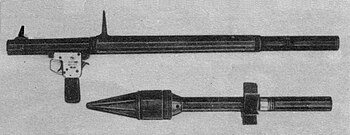RPG-2
| RPG-2 | |
|---|---|
| general information | |
| Surname: | RPG-2 |
| Country: | Soviet Union |
| Production period: | from 1947 |
| Dimensions | |
| Overall length: | 1494 mm |
| Length of launch tube: | 950 mm |
| Grenade length: | 500 mm without, 670 mm with propellant cartridge |
| Weight: (unloaded) |
2.75 kg |
| Weight grenade: | 1.84 kg |
| Weight grenade (without propellant cartridge): | 1.62 kg |
| Technical specifications | |
| Caliber tube: | 40 mm |
| Caliber grenade: | 80 mm |
| Functionality: | reactive (recoilless) weapon for firing shaped charge grenades type PG-2 |
| Sight range: | 150 m |
| Effective combat distance: | 150 m |
| Rate of fire: | 4-6 rounds / min |
|
Muzzle velocity of the grenade (v 0 ): |
85 m / s |
| Penetration performance | 180 mm RHA |
The RPG-2 ( Russian РПГ-2 ) was a Soviet anti-tank weapon . The abbreviation RPG stands for rutschnoi protiwotankowij granatomjot , in German about "hand grenade launcher for anti-tank defense". The English-language “ R ocket- P ropelled G renade” is a backronym .
development
At the beginning of the Second World War , Soviet infantry weapons for anti-tank defense were based on the principle of classic ballistic anti-tank rifles , i.e. large-caliber firearms with a rifled barrel. The effect of the bullets in caliber 14.5 × 114 mm was, however, insufficient compared to the armor of modern battle tanks . The way out of this impasse offered reactive (recoil-free) weapons with a shaped charge warhead .
On the basis of developments that had already started in the prewar period, but also influenced by the German Panzerfaust , the RPG-2 was developed after the Second World War.
The advantages of the reactive grenade launcher were, on the one hand, the elimination of the recoil of anti-tank rifles, which is difficult to control, and, on the other hand, the increased armor-piercing effect combined with lower weight.
The weapon was produced under license in various states, including China and North Vietnam. The Vietnamese People's Army called them B-40 and used them in large numbers in the Vietnam War .
function
The effect of the projectile against armor is not based on its force, but on the principle of the hollow charge . The shell was able to penetrate steel armor plates 180 mm thick on impact.
disadvantage
The armor-piercing performance soon proved to be inadequate. Above all, however, it was criticized that the trajectory of the grenade was not very stretched, which made it difficult to aim precisely at the target. These disadvantages were eliminated with the improved successor to the weapon, the RPG-7 . Their grenade had a flatter trajectory with a rocket engine and a higher penetration effect.
Replicas
The People's Republic of China made a copy of the RPG-2 as a model 56 40/80 mm. The penetration power should be slightly higher than that of the RPG-2.
Individual evidence
- ↑ Günter Wollert, Reiner Lidschun, Wilfried Copenhagen : small arms . (1945-1985). In: Illustrated encyclopedia of rifles from around the world . 5th edition. tape 1 + 2 . Brandenburgisches Verlagshaus, Berlin 1988, ISBN 3-89488-057-0 , weapons, p. 179 .
literature
- Ilya Shaydurov: Russian close combat equipment: types, technology, data . 1st edition. Motorbuch, 2017, ISBN 978-3-613-03974-2 , pp. 155 ff .
- Günter Wollert, Reiner Lidschun, Wilfried Copenhagen : small arms . (1945-1985). In: Illustrated encyclopedia of rifles from around the world . 5th edition. tape 1 + 2 . Brandenburgisches Verlagshaus, Berlin 1988, ISBN 3-89488-057-0 , weapons, p. 422-423 .
